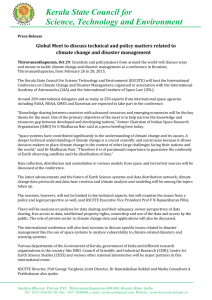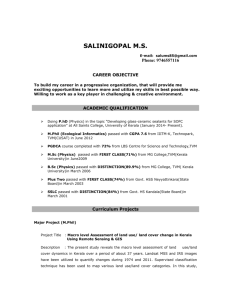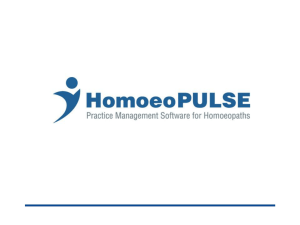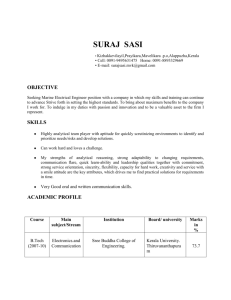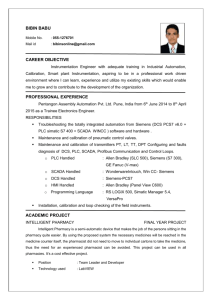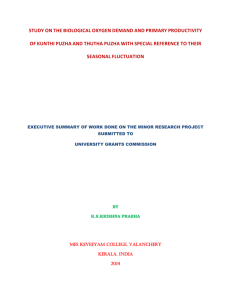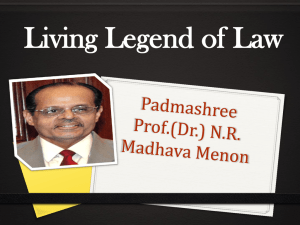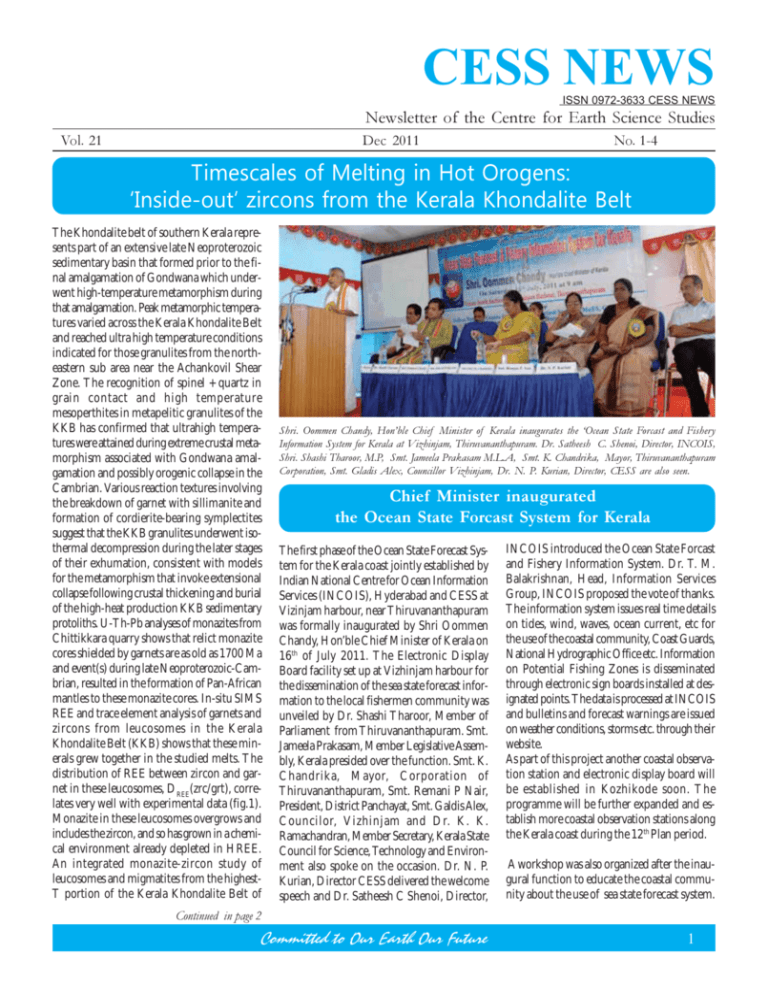
CESS NEWS
ISSN 0972-3633 CESS NEWS
Newsletter of the Centre for Earth Science Studies
Vol. 21
Dec 2011
No. 1-4
Timescales of Melting in Hot Orogens:
‘Inside-out’ zircons from the Kerala Khondalite Belt
The Khondalite belt of southern Kerala represents part of an extensive late Neoproterozoic
sedimentary basin that formed prior to the final amalgamation of Gondwana which underwent high-temperature metamorphism during
that amalgamation. Peak metamorphic temperatures varied across the Kerala Khondalite Belt
and reached ultra high temperature conditions
indicated for those granulites from the northeastern sub area near the Achankovil Shear
Zone. The recognition of spinel + quartz in
grain contact and high temperature
mesoperthites in metapelitic granulites of the
KKB has confirmed that ultrahigh temperatures were attained during extreme crustal metamorphism associated with Gondwana amalgamation and possibly orogenic collapse in the
Cambrian. Various reaction textures involving
the breakdown of garnet with sillimanite and
formation of cordierite-bearing symplectites
suggest that the KKB granulites underwent isothermal decompression during the later stages
of their exhumation, consistent with models
for the metamorphism that invoke extensional
collapse following crustal thickening and burial
of the high-heat production KKB sedimentary
protoliths. U-Th-Pb analyses of monazites from
Chittikkara quarry shows that relict monazite
cores shielded by garnets are as old as 1700 Ma
and event(s) during late Neoproterozoic-Cambrian, resulted in the formation of Pan-African
mantles to these monazite cores. In-situ SIMS
REE and trace element analysis of garnets and
zircons from leucosomes in the Kerala
Khondalite Belt (KKB) shows that these minerals grew together in the studied melts. The
distribution of REE between zircon and garnet in these leucosomes, DREE(zrc/grt), correlates very well with experimental data (fig.1).
Monazite in these leucosomes overgrows and
includes the zircon, and so has grown in a chemical environment already depleted in HREE.
An integrated monazite-zircon study of
leucosomes and migmatites from the highestT portion of the Kerala Khondalite Belt of
Shri. Oommen Chandy, Hon’ble Chief Minister of Kerala inaugurates the ‘Ocean State Forcast and Fishery
Information System for Kerala at Vizhinjam, Thiruvananthapuram. Dr. Satheesh C. Shenoi, Director, INCOIS,
Shri. Shashi Tharoor, M.P, Smt. Jameela Prakasam M.L.A, Smt. K. Chandrika, Mayor, Thiruvananthapuram
Corporation, Smt. Gladis Alex, Councillor Vizhinjam, Dr. N. P. Kurian, Director, CESS are also seen.
Chief Minister inaugurated
the Ocean State Forcast System for Kerala
The first phase of the Ocean State Forecast System for the Kerala coast jointly established by
Indian National Centre for Ocean Information
Services (INCOIS), Hyderabad and CESS at
Vizinjam harbour, near Thiruvananthapuram
was formally inaugurated by Shri Oommen
Chandy, Hon’ble Chief Minister of Kerala on
16th of July 2011. The Electronic Display
Board facility set up at Vizhinjam harbour for
the dissemination of the sea state forecast information to the local fishermen community was
unveiled by Dr. Shashi Tharoor, Member of
Parliament from Thiruvananthapuram. Smt.
Jameela Prakasam, Member Legislative Assembly, Kerala presided over the function. Smt. K.
Chandrika, Mayor, Corporation of
Thiruvananthapuram, Smt. Remani P Nair,
President, District Panchayat, Smt. Galdis Alex,
Councilor, Vizhinjam and Dr. K. K.
Ramachandran, Member Secretary, Kerala State
Council for Science, Technology and Environment also spoke on the occasion. Dr. N. P.
Kurian, Director CESS delivered the welcome
speech and Dr. Satheesh C Shenoi, Director,
INCOIS introduced the Ocean State Forcast
and Fishery Information System. Dr. T. M.
Balakrishnan, Head, Information Services
Group, INCOIS proposed the vote of thanks.
The information system issues real time details
on tides, wind, waves, ocean current, etc for
the use of the coastal community, Coast Guards,
National Hydrographic Office etc. Information
on Potential Fishing Zones is disseminated
through electronic sign boards installed at designated points. The data is processed at INCOIS
and bulletins and forecast warnings are issued
on weather conditions, storms etc. through their
website.
As part of this project another coastal observation station and electronic display board will
be established in Kozhikode soon. The
programme will be further expanded and establish more coastal observation stations along
the Kerala coast during the 12th Plan period.
A workshop was also organized after the inaugural function to educate the coastal community about the use of sea state forecast system.
Continued in page 2
Committed to Our Earth Our Future
1
Director Speaks
India is bestowed with a wide variety of valuable mineral
resources. Among them, the beach placer deposits have a
unique position because of their high export demand and
industrial significance. Placer or heavy minerals (specific
gravity > 2.9) get concentrated in various pockets of beach
as well as inland, along active and submerged channels. In
fact, Kerala hosts some of the best and largest heavy mineral placer concentrations of the world. Therefore, CESS
since its inception, has carried out a number of scientific projects to understand
their concentration mechanism, economic potential, mineral chemistry and
provenance. The chief minerals of these reserves are ilmenite, rutile, zircon,
monazite and garnet.
Continued from page 1
southern India (P-T: 7 kbar, 930°C) has demonstrated that
high-percentage melting (>20 vol%), leucogranitic melt migration, and interaction of melt with host rocks consequent on
melt ponding and crystallisation occurred over a prolonged
time interval of at least 25 Ma, from at least ca. 560 Ma to 535
Ma. Here we report results from one leucosome-rich migmatite
(KUL), in which zircons preserve a remarkable textural record
of growth, dissolution and modification. We have applied REE
analysis to evaluate the growth behaviour of these unusual
zircons and devised our strategy for the subsequent zircon UPb isotopic dating.
Recently, the attention of placer-geologists have turned into value addition of
these minerals because of significant high-end applications, such as in aircraft,
space and nuclear industries. In this context, a couple of studies carried out by
this Centre have brought out interesting conclusions. The bulk and complex
beach deposits bear specific grades of individual minerals, which belong to
either various rock types or formed due to characteristic depositional environments. The inherent physico-chemical heterogeneity of minerals helps in the
separation of different grades from the raw ore. The intrinsic property of grades
could be grain size, magnetism, specific gravity, electric conductance or radioactivity. Since each separated grade has compositional heterogeneity, they can be
beneficiated to produce specific-quality end products.
In the case of ilmenite and zircon, crystals relatively free of intergrowths decide
their economical value. Earlier, ilmenite was essentially used only for the manufacture of pigments and paints. However, the demand of titanium and titanium based products coupled with the scarcity of natural rutile has dramatically increased the scope of this mineral. Similarly, zircon that has been conventionally used in refractories and as opacifier in tiles and sanitary ware is largely
being used for extraction of zirconium, hafnium and several zirconium based
produts. Further, the application of garnet in various types of abrasive and the
use of monazite in thorium-based nuclear energy plants underline the requirement of detailed characterization of all placer minerals in terms of their physicochemical properties. Premium prices can also be charged to the high-quality
raw grades, instead of exporting mineral concentrates in composite form.
Sorting of ilmenite and zircons of Kerala beach placers has confirmed that
industrially viable grades exist with respect to magnetism for ilmenite and
specific gravity and texture for zircon. Mineral processing at laboratory scales,
based on these two minerals, have confirmed that an initial grading followed by
beneficiation adds significant economic value to our limited coastal mineral
resources. Variations of mineral grades in terms of micromorphology, colour,
shape, major, minor and trace elements etc. have been documented. Parameters
like Fe/Ti ratios, Mg-Mn contents, Zr/Hf ratios and light rare earth elements
content were found to be the key chemical indicators supporting the above
inferences. Studies on monazite are being taken up for similar evaluation.
As various mineral processing units exist in southern India under state, central
and private ownerships, additional research intervention is warranted to take
care of the interests of all stakeholders in this important sector. Our sophisticated analytical tools and association with various industrial units, universities
and institutes in the region are expected to significantly enhance our knowledge on this topic.
Dr. N. P. Kurian
2
Fig. 1 CL (a, c, d) and SEI (b) images of zircon features in KUL. (a)
shows the typical internal features of a zircon with a ‘complete’ core region
and outer planar-zoned material, with some invasion of one sector by lobe of
modified zircon, circular zircon in another sector, and a preserved former
melt inclusion in another. (b) shows a nanogranite inclusion. (c) shows two
grains welded together along a dissolution-reprecipitation front. (d) shows a
composite of possibly 3 zircons (indicated by the trellis features) highly
modified by invasive lobes.
KUL zircons preserve complex cores, planar-sector to ‘firtree’
and oscillatory zoned euhedral rim domains (‘bright planar’
and ‘dark planar’), and darker-CL rinds and invasive lobes (Fig.
1a). Complete ‘cores’ have square cross sections, divided into
sectors by axial zones of dark-CL zircon that form trellis and
feathery structures. Intervening bright-CL sectors contain either an inclusion of quartz or finely crystalline quartzofeldspathic
material (Fig. 1b), or a circular to elliptical domain of markedly
zoned zircon (Fig. 1a, 1c) that may be continuous with the
lobes of invasive darker-CL zircon. Fig. 1c shows a composite
zircon grain pair, in which one complex core has later been
disrupted and replaced by a truncating lobe or domain of darkCL zircon. The other complex core is mostly intact, with axial
trellis zones, 1 inclusion, 2 circular oscillatory domains and one
invasive lobe.
Structurally simpler planar-sector zoned zircon surrounds the
complex cores. Two planar-sector zone types occur: those that
are brighter in CL (‘bright planar’) and moderately oscillatory,
and those that are darker in CL (‘dark planar’) and weakly
oscillatory. Both ‘core’ and ‘planar-sector’ type zircon domains
are variably truncated, modified or replaced by lobate,
curviplanar, ‘swirling’ and cuspate zircon domains (‘lobate zircon’) that also form outermost rinds (Fig. 1d). This lobate zir-
Committed to Our Earth Our Future
Fig. 2. Zircon Rare Earth Element patterns. Bright-CL planar-sector and axial zircon domains are high and
fractionated in HREE (Ybn/Gdn = 5.7 – 2.7; Dyn = 140-520) compared with darker-CL planar, interior
lobate and modified domains, which have flat HREE (Ybn/Gdn = 0.9; Dyn =130). Garnet patterns (not shown)
are characterised by flat HREE (Ybn/Gdn = 1.2) at Dyn = 165.
con, whether on rims or invasive into complex cores, represents the final phase of KUL zircon
formation and modification.
The timing relationships between the spectacular complex core zircon domains and the planarsector euhedral zircon zones are ambiguous. The complex cores show internal modifications
that appear to truncate or interact with the most ‘internal’ of the planar-sector zones. This,
coupled with the common observation of inclusions with negative crystal shapes, similar in
Fig. 3. Distribution of MREE-HREE between the two zircon textural types and garnet in KUL. Pairing of the
planar-sector zoned zircon with garnet yields DHREE that range from 1.7 at Gd to 5.1 at Yb, far removed from
equilibrium. Pairing of the dark-zoned and modified zircon with garnet yields DHREE that overlap with the
preferred empirical equilibrium values at 850-1000°C (Harley et al., 2007) and lie within range of experimental
DREE results (Rubatto & Hermann 2007). KUL zircon has undergone its late-stage crystallisation and
modification in the presence of and in close equilibrium with garnet
Committed to Our Earth Our Future
mineralogy and micro texture to ‘nanogranite’,
suggests that the zircons may have grown as
‘hopper’ crystals in which the planar-sector
euhedral rims grew faster than cores. In this
‘inside-out’ growth model zircon cores would
have contained tubes of melt, filled by latestage zircon growth. This model is evaluated
using the REE results, and will be tested further using zircon U-Pb dating
REE and other selected trace elements within
zircons and garnets were determined using the
EMMAC CAMECA ims-4f ion microprobe
(University of Edinburgh). Analytical conditions and correction procedures follow those of
Harley & Kelly. Analyses were conducted using a 6 nA O- primary beam. Secondary ions
were extracted at 4500V and measured at a
120eV high-energy offset for zircon and 75eV
energy offset for garnet. Trace element abundances were calibrated against the NIST-610
glass standard and ion yields corrected by reference to zircon SL1 and garnet DDI garnet.
Trace element chemistry allows distinction of
the texturally-defined bright-CL planar zircon
from the dark-CL, weakly zoned but undisturbed zircon cores, elliptical / circular modified core zircon, and lobate invasive zircon. The
former shows elevated and fractionated HREE
(red diamonds in Fig. 2), moderate Th/U>0.3
and low U/Yb = 2.8. The latter types, grouped
together on Fig. 2, have moderate and flat
HREE, Th/U<0.3, and high U/Yb (20-64).
Details of these zircon chemistries and the measured garnet REE features are provided in the
captions to Fig. 2 and Fig. 3.
The REE data indicate that only the darkerzoned and modified zircon, formed in the presence of melt, approached equilibrium with hostrock garnet. Initial zircon crystallisation from
melt, producing ‘hopper’ type zircon with outer
planar-sector zoning, occurred in a melt-rich
open system prior to interaction of the melt
with garnet. Garnet-melt interaction later accompanied the continued precipitation of zircon as modified lobes and tubes filling meltbearing zircon grains as the melt crystallised.
The age of this phase of melt crystallisation,
interaction and garnet-zircon-melt equilibration
should be at least 535 Ma, the age obtained
from the main monazite population in KUL.
V. Nandakumar and Simon L. Harley*
*
School of GeoSciences, University of Edinburgh,
Edinburgh EH9 3JW, UK
3
Kinetic and equilibrium modeling. CLEAN –
Soil, Air, Water, 38(4) pp. 361-369.
Publications
Papers published in Journals
Anoop Krishnan K,Sreejalekshmi, K G, Baiju
R S (2011) Nickel(II) adsorption onto biomass
based activated carbon obtained from sugarcane bagasse pith. Bioresource Technology,
DOI10.1016/ j.biortech.2011.08.069.
Sharreekul Ansar, Dhanya C R, George Thomas, Aswathy Chandran, Liji John, Prasanthi
S, Vishnu R, and Zacharizh E J (2011) A Study
of Urban/Rural Cooling Rates in
Thiruvananthapuram, Kerala, J. Ind. Geophys.
Union, 16(1): pp. 29-36.
Jayanthi J L, Subhash N, Manju S, Philip E K,
and Beena V T(2011) Diagnostic evaluation
of the diagnostic performance of
autofluorescence and diffuse reflectance in oral
cancer detection: a clinical study, J.
Biophotonics, 4(10), 696-706, DO:10.1002/
jbio.201100037, 2011.
Sudhanandh V S, Udayakumar P, Ouseph P P,
Amaldev S and Narendra Babu K (2011) Dispersion and assimilation trend of heavy metals
in coastal and estuarine sediment and its textural characteristics: A case study in India, J.
Human Ecology, 36(2), pp.85-90.
Suresh Kumar P Nair, Shenoy K T,
Muralidharan V, Vijayalakshmi N R, Nikhil S,
Ancy Simon, Neethu Varghese, and Vidhya
Ramaswamy (2011) Study of morbidity pattern of a population exposed to industrial air
pollution at Trivandrum and Pune, BIOINFO
Environment and Pollution, 1(1), pp.01-04.
Udayakumar P, Jean Jose J, Rajesh B R and
Narendra Babu K (2011) ‘Seasonal dynamics
of dissolved metals in surface coastal waters of
SW India, Bulletin of Environmental Contamination and Toxicology, DI:10.1007/S128011-0402-0.
Sheela Nair L, Sundar V and Kurian N P
(2011) Numerical Modelling Studies on the
Effect of Breakwater on Coastal Processes- A
Case Study along a stretch of Kerala Coast India, Int. J. of Ocean and Climate Systems, Volume 2, Number 4, December 2011, pp.291302.
Sudhanandh V S, Shibu R, Ajimon V J and
Narendra Babu K ( 2011) Water quality effects of harbour activities accessed with integrated eco-toxicological parameters in Kerala,
India, African J. Environmental Science and
Technology, 5(11), pp.924-932.
Vijaya Kumar & Chattopadhyay S (2011)
House hold energy consumption in rural Kerala,
India: Lessons from four grama panchayats,
Annals National Association of Geographers,
India, XXXI (1), pp.12-20.
Thomas G and Zachariah E J (2011) Urban
heat island in a tropical city interlaced by
wetland’s J. Environmental Science and Engineering, 5, pp.234-240.
Padmalal D, Remya S I, Jissy Jyothi S, Baijulal
B, Narendra Babu K (2011) Water quality and
dissolved inorganic fluxes of N, P, So4 and K of
a small catchment river in the Southwestern
Coast of India, Environmental Monitoring and
Assessment, DOI:10.1007/s10661-0112059-X.
Baba M, Jean Jose J, Udaya Kumar P and
Narendra Babu K (2011) Unusual foaming
along Thiruvananthapuram coast, Scientific
Correspondence, Current Science, 100(8), pp.
1121.
Sudhanandh V S, Ouspeh P P and Narendra
Babu K (2011) Zooplanktons role in the distributional status of autochthonous
Vibriocholerae, a case study using principal
analysis, J. Environmental Science and Engineering, 52(4), pp.321-325.
Jayanthi J L, Nisha Unni, Manju S, Philip E
K, Jeemon P, Baiju KV, Beena V T and Subhash
N (2011) Diffuse reflectance spectroscopy:
Diagnostic accuracy of non-invasive screening
technique for early detection of malignant
changes in the oral cavity, British Medical Journal (BMJ Open), DOI: 10.1136/bmjopen2011-000071.
Papers published in Proceedings/Books
Sreeba S and Padmalal D (2011) Environmental impact assessment of sand mining from the
small catchment rivers in the south western
coast of India: A case study. J. Environmental
Management, 47, pp.130-140.
Sheela A M, Letha J, Sabu Joseph,
Ramachandran K K and Manoj Chacko,
(2011) Computation of physical characteristics of a lake system using IRS P6 (LISS-iii) imagery, Int. J. Applied Earth Observation and
Geoinformation, pp-222-232.
Anjali R, Mohan Kumar. G, Sreekanth T S
(2011) Anomalous variations in atmospheric
Carbon Monoxide associated with the Tsunami, Asian J. Atmos. Environ., 5(1), pp 4755.
Anu Baburaj N, Subhash N,Prasanth C S and
Prakash T N (2011) Laser-induced Fluorescence spectral Signatures of Corals in
Lakshadweep and Palk bay, Int. J. Oceans and
Oceanography, Volume 5 (2), pp.143-152.
Jean Jose J, Udayakumar P, Chandran A,
Narendra Babu K and Sudhanandh V S (2011)
zooplankton diversity in Vallarpadam, India:
influence of hydrochemistry, season and semi
diel cycle. Asian J. Water, Environment and
Pollution, 8(1), pp.103-108.
Anoop Krishnan K, Sreejalakshmi K G, Sumol
Varghese, and Anirudhan T S (2010) Removal
of EDTA from aquous solutions using activated
carbon prepared from sawdust of rubber wood:
Shiny Sara Thomas, Jayanthi J L, Narayanan
Subhash, Joji Thomas, Rupananda Mallia and
Aparna G N (2011) Characterization of dental
4
caries by LIF spectroscopy with 404 nm excitation, Lasers Med Sci., 26(3): pp. 299-305
DOI: 10.1007/s10103-010-0771-3.
Committed to Our Earth Our Future
Dhanya G, Renoy G, Ramachandran K K and
Mookambiga A (2011) Assessment of run-off
charcteristics in Thiruvananthapuram City using Techniques of Geo-informatics. In Proc.
Conference on Remote Sensing and GIS for
Environmental Management, World Education New Delhi, pp.77-93.
Sampad Kumar Panda, Shirish S Gedam,
Deepak R, Raghavendra Balerao and Sri.
Sukumar B (2011) Satellite remote sensing and
its applications for sustainable agricultural development in Peruvumba river basin, Kannur
district, Kerala Proc.2 nd Nat. Conf. on
Geospatial Technologies and Applications,
CSRI, IIT, Mumbai, pp. 220-226.
Vishnu Mohan S, Anooja S, Baiju R S and
Padmalal D (2011) Indication of sea level
changes on sediment dispersal pattern of a tropical river and estuary, SW, India. Proc.24th Annual Convention of Indian Institute of Geo-
morphologists and Nat. Conf. on Coastal Dynamics and Geomorphology, Anna University,
Chennai, pp. 40-41.
Archana M Nair and Soumya G S (2011) Spectral analysis of Reiner Gamma Lunar Swirl using M3 data, Proc. Conf. Planetary Sciences
and Exploration PLANEX 12-14 December
2011 at PRL, Ahmedabad, pp.23-24
Mohanan C N, Thomas K V (2011) The Status of Mangroves in Kerala, In: Towards Conservation and Management of Mangrove Ecosystems in India (Eds) Bhatt J R, Macintosh D
J, Nayar T S, Pandey C N and Nilaratna N P,
IUCN, India, pp. 154-159.
Rupananda Mallia and Subhash N (2010)
Photodiagnosis of Oral Malignancy-Basic,
Translational and Clinical, Lap Lambert Academic Publishing GmbH, Germany, 175p.
Papers Presented in Conferences
Jayanthi J L, Manju S and Subhash N presented a paper entitled ‘Diffuse Reflectance
imaging: A new perspective in Oral Cancer
Diagnosis’ in the 23rd Kerala Science Congress
2011.
Raji S Nair, Aparna G Nair and Subhash N
presented a paper entitled ‘Integration of a
multispectral imaging system consisting of
EMCCD camera and liquid crystal tunable filter using labview’ in the 23rd Kerala Science
Congress 2011.
Prasanth C S and Subhash N presented a paper entitled ‘Effective Antimicrobial Photodynamic Therapy against E Faecalis using Endogenous Photosensitizer’ in the 23rd Kerala Science Congress 2011.
Lekha G L and Narendra Babu K presented a
paper entitled ‘Sediment interstitial water phosphorus and the controlling factors that affects
its migration to overlying water: A case study in
two lake systems of different environments’ in
the 23rd Kerala Science Congress 2011.
Jean Jose J, Vishnu S Raj, Udayakumar P, Baiju
R S and Narendra Babu K presented a paper
entitled ‘Extraction of marine microalgal chlorophyll pigment using Soxhlet apparatus for
estimation-a convenient and effortless approach’ in the 23rd Kerala Science Congress
2011.
Prijilal K G, Omana P K, Rajesh B R, Sajith U
and Sindhu S presented a paper entitled ‘Heavy
metal Accumulation in the Estuarine Fishery
Resource: A case study from Vembanad Estuarine System, Kerala, South West India’in the
23rd Kerala Science Congress 2011.
Resmi R, Baburaj B, Santhosh V, Sreebha S
and Padmalal D presented a paper ‘EIA of
river sand mining using Rapid Impact Assessment Matrix (RIAM)- A case study’ in National Seminar on Mining of river sand held at
CWRDM Kozhikode, 18-19 February, 2011.
Anooja S, Baijulal B, Maya K, Sreeba S and
Padmalal D presented a paper ‘Impact of sand
mining on river bed changes and bed material
characteristics-a case analysis’ in National Seminar on Mining of river sand held at CWRDM
Kozhikode, 18-19 February, 2011.
Baijulal B, Jissy Jyothi S, Padmalal D, Maya K
presented a paper ‘Environmental effects of alluvial sand mining on the biological environment of Kerala rivers’ in National Seminar on
Mining of river sand held at CWRDM
Kozhikode, 18-19 February, 2011.
Vishu Mohan S, Sreebha S, Padmalal D, Maya
K and Lini Krishna presented a paper ‘Sand
mining in Pamba river’ in National Seminar on
Mining of river sand held at CWRDM
Kozhikode, 18-19 February, 2011.
Narendra Babu K and Anoop Krishnan K presented the following papers ‘Mapping and
hydrochemical evaluation of coastal Spring of
Southern Kerala, India, An alternate drinking
water resource with high potential’ and ‘Impact of Urbanization on hydrochemical characteristics of three main cities,
Thiruvananthapuram, Kochi & Kozhikode in
Kerala, India’ in International Conference Sustainable Water Resource Management and
Treatment Technologies at NEERI, Nagpur,
19-21 January, 2011.
Sukumar B presented a paper ‘Geomatic application for prioritization of watershed for watershed management in Kannur district, Kerala’
in National seminar on Emerging Frontiers in
Geomatic Applications ENFROG 2011 held
at School of Earth and Atmospheric Sciences,
Madurai Kamaraj University, Madurai, 21-22
March, 2011.
Ahalya Sukumar and Sukumar B presented a
paper ‘Growth of Chennai city and its envi-
Committed to Our Earth Our Future
ronmental impact: A study usiung Satellite remote sensing and GIS’ in National seminar on
Emerging Frontiers in Geomatic Applications
ENFROG 2011 held at School of Earth and
Atmospheric
Sciences,
Madurai
KamarajUniversity, Madurai, 21-22 March,
2011.
Deepthi B, Sukumar B and Ahalya Sukumar
presented a paper ‘Changing occupational
structure of Kollam district, Kerala: A study
using GIS’ in National seminar on Emerging
Frontiers in Geomatic Applications ENFROG
2011 held at School of Earth and Atmospheric
Sciences, Maduraj Kamaraj University,
Madurai, 21-22 March, 2011.
Savitha Vijayan, Sukumar B and Ahalya
Sukumar presented a paper ‘Study of urbanization in Kannur district, Kerala through GIS’
in National seminar on Emerging Frontiers in
Geomatic Applications ENFROG 2011 held
at School of Earth and Atmospheric Sciences,
Madurai Kamaraj University, Madurai, 21-22
March, 2011.
Ahalya Sukumar and Sukumar B presented a
paper ‘Urbanisation between Kochi and
Thrissur: An Integrated study using satellite
Imagery and census data in GIS environment’
in XXXI INCA International Conference at
Chandigarh, October 2011.
Sandhya S, Deepthi P, Sukumar B and Ahalya
Sukumar presented a paper ‘Landuse land cover
changes and its impact in Kollam district, Kerala:
A study using GIS and Remote sensing’ in XXXI
INCA International Conference at Chandigarh,
October 2011.
Deepthi P, Sukumar B, Ahalya Sukumar and
Sandhya S presented a paper ‘Mapping of soil
moisture in Kollam District using NDVI and
Tasseled cap analysis Authors’ in XXXI INCA
International Conference at Chandigarh, October 2011.
Sukumar B, Ahalya Sukumar, Sulfikkar M,
Savitha Vijayan and Nadheer Bin Haneef O
presented a paper ‘Land and water conservation in Kannur district, Kerala: Watershed based
GIS Analysis’ in XXXI INCA International
Conference at Chandigarh, October 2011.
Sulfikkar M, Nadheer Bin Haneef O, Ahalya
Sukumar and Sukumar B presented a paper
‘Panchayat wise analysis of food prone area and
its impacts on agriculture in Kannur district,
5
Kerala’ in XXXI INCA International Conference at Chandigarh, October 2011.
Nadheer Bin Haneef O, Sukumar B and
Ahalya Sukumar presented a paper ‘Urban
growth and planning strategies in Kannur
municipality, Kerala using Remote sensing and
GIS’ in XXXI INCA International Conference
at Chandigarh, October, 2011.
Sudhanandh V S, Faisal A K, Vishnu S Raj,
Baiju R S, Shibu R, Rajesh B R and Narendra
Babu K presented a paper ‘Physico-Chemical
factors on the association of vibrio cholerae with
phytoplankton, a case study using principal
component analysis’ in National seminar on
Current Trend in Biotechnology and
Bioinformatics held at NSS College
Changanassery.
Omana P K , Prijlal K G, Rajesh B R, Sajith U
and Sindhu S presented a paper ‘Effects of
Vilappilsala Waste treatment Plant lechate on
surface and ground water quality status of
Nearby Areas’ in National seminar on Current
Trend in Biotechnology and Bioinformatics
held at NSS College Changanassery.
Ravindra Kumar G R presented a paper
‘Growth and evolution of the Kerala Khondalite
Belt, southern India: mineral and whole rock
chemical evidence for intracrustal melting and
magmatic petrogenesis’ in American Geophysical Union conference.
Jayaprasad B K presented a paper ‘Fragility
Mapping for a strip of the western ghats using
GIS- A case study in Amboori Gramapanchayat
in Thiruvananthapuram district of Kerala State’
in INCA International Seminar at Chandigarh,
16 October, 2011.
Padmalal D, Kumaran K P N, Nair K M, Ruta
B Limaye and Vishnu Mohan S presented a
poster on ‘Late Quaternary Evolution of
Vembanad Lagoon in the southwestern coast
of India: an appraisal of sedimentary record of
sea level and climate change’ in the XVIII,
INQUA Congress, held at Bern, Switzerlan
22nd July, 2011.
Ruta B Limaye, Kumaran K P N and Padmalal
D presented a poster on ‘How did mangrove
vegetation respond to Holocene sea level and
climatic change along Konkan-Kerala coast of
southwestern India?’ in the XVIII, INQUA
Congress, held at Bern, Switzerland, 22nd July,
2011.
6
Vandana M presented a paper ‘A
pedogeomorphic analysis of Kabani river basin
in Wayanad district, Kerala’ in International Geography Congress held at CWRDM,
Kozhikode, 6-8 May, 2011.
Arun R presented a paper ‘Feature space analysis for the classification of water bodies’ in International Geography Congress held at
CWRDM, Kozhikode, 6-8 May, 2011.
Arunima R, Noufal K N, Faisal A K, Sreejith M
I, Arya S, Liji T M, Baiju R S and Anoop
Krishnan K presented a poster on ‘Natural
springs-A promising solution for water scarcity
in future?’ National seminar of Frontiers in
chemistry, Held at IIST, ISRO, Valiyamala,
TVM, 7-8 December, 2011.
Anu baburaj, Subhash N, Nisha Unni, Anil M
K and Rani Mary George presented a paper
‘Laser-induced fluorescence imaging: A potential tool for early detection of coral bleaching’
in 9th Indian Fisheries Forum, Chennai, 19-23
December, 2011.
Sri. B K Jayaprasad delivered a lecture on Remote Sensing and GIS as a toll for Bio-resource
Assessment on July 29, 2011 at Kerala Agriculture University.
Dr. P V S S K Vinayak delivered a lead talk on
Global Warming on Climate Change in a national seminar at Acharya Nagarjuna University, Guntur.
Dr. A S K Nair delivered lectures on‘Water Resources and Irrigation Issued in Kerala’ and ‘Remote Sensing and GIS’ during the STP Training Programme on GIS at the IMG,
Thiruvananthapuram on 2nd September, 2011.
Dr. A S K Nair delivered a lecture on Participatory Rural Appraisal in the one day training
programme under the Westernghat Development Programme on 29th September, 2011 at
VJT Hall, Thiruvananthapuram.
Visit in
Abrad
Membership
Committees
Dr. N. P. Kurian
Invited
Talks
Visit Abrad
Dr. Srikumar Chattopadhyay delivered a lecture on Sustainable management of common
property natural resources: macro perspective
and micro act in the International Geography
Congress held at CWRDM, Kozhikode, May
6, 2011.
Dr. Srikumar Chattopadhyay delivered a lecture on Disaster Management and Role of Local Self Government for the delegates from
Bihar, Jharkhand & West Bengal.
Dr. K. Anoop Krishnan delivered a lecture on
Water Quality status in Peninsular India-problems and possible remedies in the International
Workshop on Asian water Environments (JSPS
Asian Core Programe) on January 26, 20111
at Tokyo Institute of Technology, Tokyo, Japan.
Sri. G Sankar delivered a talk on Natural Disasters of Kerala in the Disaster, Risk and Vulnerability conference 2011 organized by the
School of Environmental Sciences, MG University, Kottayam, March 12, 2011.
Sri. G Sankar delivered a talk on piping in the
meeting organized by Madhavan Pillai foundation on March 19, 2011 at Trivandrum.
Committed to Our Earth Our Future
Member, Project Management Board, Coastal
Engineering Division, National Institute of
Ocean Technology, Ministry of Earth Sciences,
Government of India.
Member, Board of Studies in Physical Oceanography under the Faculty of Marine Sciences,
Cochin University of Science and Technology,
Cochin.
Member, Kerala Dam Safety Authority by Water Resources (Inter State Water Cell) Department, Government of Kerala.
Member, Kerala Protection of River Banks of
Regulation of Removal of Sand Rules 2002 –
State High Level Committee for River Management Fund by Revenue (P) Department, Government of Kerala.
Member, Governing Body, LBS Centre for Science & Technology by Higher Education Department, Government of Kerala.
Member, Kerala Coastal Zone Management Authority by Ministry of Environment & Forests,
Government of India.
Member, Working Group for Water Sector by
Water Resources (IR) Department, Government
of Kerala.
Member, Governing Body, Institute of Land
and Disaster Management, Revenue Department, Government of Kerala.
Dr. Ajaykumar Varma
Chairman of the Committee constituted for
assessing the damages to the properties of local
people due to the blasting operations in a 7-km
long tunnel of Sengulam Augmentation
Scheme.
Expert Member in the Assessment Committee of C-DIT for the promotion of Scientist,
Thiruvananthapuram.
Dr. C N Mohanan
Member, State Level EIA Authority (SEIAA)
Member,
Technical Committee of
Karumpukonam Community Ecosystem Management Committee constituted by Dept. of
Environment & Climate Change.
Dr. N Subhash
Guest Editor of a Special Issue on Fluorescence
in Natural Systems being brought out by the
International Journal of Spectroscopy (Hindawi
Publishing Corporation, USA)
Member of the Governing Council of STIC
(Sophisticated Test & Instrumentation Centre),
Cochin.
Dr. K. V. Thomas
Member, different KCZMA subcommittees to
look into various CRZ issue of implementation, policies and violations and prepared reports.
New Arrivals in CESS Library
Yang, Xiaojin (Ed). Remote sensing and
geospatial technologies for coastal ecosystem
assessment and management. Springer, Heidelberg, 2009.
Kalacska, Margaret and Sanchez-Azofeifa, G
Arturo (Ed). Hyperspectral remote sensing of
tropical and sub tropical forests. CRC Press,
Boca Raton, 2009.
Pinker, Steven. The language instinct: the new
science of language and mind. Penguin Books,
London, 1994.
Koestler, Arthur and Butterfield, Herbert.
Sleepwalkers. Penguin books, London, 1989.
Ball, Philip. H2O: A biography of water. Phoenix, Britain, 1999.
Feynman, Richard. The pleasure of finding
things out. Penguin Books, London, 1999.
Sri. Shinaj P.H
Office Assistant Grade 1
joined Accounts Section
Hawking, Stephen and Mlodinow, Leonard.
The grand design. Bantam Dell Publishing
Group, New York, 2010.
Smt. Anju. K. S
Office Assistant Grade 1
joined Administration
Section
Goldys, Ewa M. Fluorescence applications in
bio-technology and the life sciences. WileyBlackwell, New York, 2009.
Allan, Catherine
Stankey, George H.(Eds.).
VisitandAbrad
Adaptive environmental management.
Springer, Heidelberg, 2009.
Sri. Sudheer Kumar K,
Driver Grade 1 joined
Administration Section
Sri. Shensha C, Office
Assisatant Grade 1 resigned on 31st January
2011 to take up employment in IIMK, Kozhikode
Sullivan, Patrick J., Agardy, Franklin J. and
Clark, James J.J. The environmental science of
drinking water. Elsevier, Amsterdam, 2005.
Boggs, Sam Jr. Principles of sedimentology and
stratigraphy.4th ed. Pearson Prentice Hall, New
Jersey, 2010.
Grigg, Neil M. Water resources
management:principles, regulations and cases.
Mc-Graw Hill, New York, 2009.
Southward, Alan J., Young, Craig M. and
Fuiman, Lee A.(Eds.). Advances in marine biology. Vol.50. Elsevier, Amsterdam, 2006.
Buchholz, Klaus and Collins, John. Concepts
in biotechnology: history, science and business.
Wiley-VCH, Weinheim, 2010.
Nierenberg, William A.(Ed.). Encyclopedia of
rnvironmental biology. Vol.1-3. Academic
Press, Amsterdam, 1995.
Recruitments/Resignations
Hall,G.Brent and Leahy, Michael G.
(Eds.).Open source approaches in spatial data
handling. Springer, Heidelberg, 2008.
Hawking, Stephen. A brief history of time.
Bantam Dell Publishing Group, New York,
1989.
Smt. Shimla D,
Office Assistant Grade 1
joined Stores Section
Smt. Indu Janardhanan,
Technical Officer Grade 1
joined Estate Administration
Committed to Our Earth Our Future
Sri. Subair V, Technical
Officer Grade 1 resigned
on 6th June 2011 to take
up employment in IIMK,
Kozhikode
Visit
Obituary
Abrad
Dr. P. K. Iyengar
Dr. P. K. Iyengar, former
Chairman of the Executive
Committee of CESS and
former Chairman of State
Committee on Science
Technology and Environment expired on 21st December 2011
Sri. K. R Unnikrishnan
Sri. K. R Unnikrishnan,
Scientist-F, attached to
the Camp Office CESS
expired on 26th June
2011 after prolonged illness.
7
Prof. C. Karunakaran Endowment Lecture Series
Scientists interacting with students of Bishop Hodges
Higher Secondary School, Mavelikkara
Earth Day 2011
Prof. Raghuram Murtugudde, Dept. of Atmospheric and Ocean Sciences of the Earth System Science
Interdisciplinary Centre, University of Maryland, U.S.A delivering the Endowment Lecture
Prof. Raghuram Murtugudde, Dept. of Atmospheric and Ocean Sciences of the Earth
System Science Inter-disciplinary Centre, University of Maryland, U.S.A, delivered the 10th
lecture in the Prof. C.Karunakaran Endowment lecture series on 16th July 2011 at the
CESS auditorium. The topic of the lecture
was ‘Earth, Life and Sustainability: A longterm perspective.
Prof. Murtugudde is internationally acclaimed for his contributions in earth system
modelling. At present he is working on regional earth system prediction. The lecture
was attended by a large gathering of scientists
and students from other institutions in and
around Thiruvananthapuram. Dr. N. P.
Kurian, Director, CESS welcomed the gathering. Shri. M. P. Muraleedharan, former Director, Geological Survey of India paid tributes to Prof. C. Karunakaran. Dr. K.
Krishnamurthy, Director, Space Physics Laboratory, Vikram Sarabhai Space Centre introduced the speaker. Dr. Srikumar
Chattopadhyay, Head, Resource Analysis Division proposed the vote of thanks.
Visit
Abrad
Extension
various fields delivered talks and conducted interaction sessions. CESS pavilion presented
posters and models highlighting the research
activities. Malayalam brochure titled
‘Bhuchalanam: Ariyenda vasthuthakal’ and a
hand book on CESS vision were distributed
among the public.
Exhibition
CESS participated in the exhibition organized
in connection with the ‘Karshika Mela’ (Agricultural fair) held at Thodupuzha Newmans
College ground from 26th December 2011 to
CESS also organised and participated in the
exhibition held during the 23rd Kerala Science
Congress conducted in CESS from January
29-31, 2011.
Interaction programmes
A view of the exhibition stall of CESS at the agricultural
fair held at Thodupuzha
1st January 2012. Every day nearly 20000
people visited the exhibition stall. Experts from
Senior secondary students from the Bishop
Hodges Higher Secondary School, Mavelikkara
visited CESS on 27th July 2011. Scientists gave
talks on Geographic Information System, Remote Sensing and Natural Hazards Management.
Committed to Our Earth Our Future
Scenes from Earth Day celebration
Earth Day 2011 was observed in CESS on 28th
April 2011. Students from different schools in
Thiruvananthapuram visited the laboratories
of CESS and interacted with the scientists. An
elocution competition for students was held
on the topic ‘Green Earth’. An invited talk on
the same topic was also arranged for students.
The talk was delivered by Shri. P. Narayana
Kurup, a noted Environmentalist. Certificates,
cash awards and mementoes were distributed
to the winners by Director, CESS.
National Science Day 2011
‘National Science Day’ was observed on 28th
February, 2011. Students from the Kendriya
Vidyalayas visited CESS laboratories. A short
talk on the focal theme, ‘Chemistry in our Lives’
was delivered by Sri.G.Balasubramonian, Scientist, CESS.
Honours/Awards
Visit Abrad
Mr. Sreejesh Kumar S, Project
Fellow, Geosciences Division
won the best poster award
during 23rd Kerala Science
Congress held at Trivandrum
during January 29-31, 2011 for
the paper titled ‘Rainwater harvesting
initiatives in Mullakkara Catchment,
Chadayamangalam Block, Kollam district’,
based on a project on the Integrated Watershed Development Programme under
8
Hariyali. The paper was co-authored by Sri.
John Mathai, Scientist-G, CESS.
Twentythird Kerala Science Congress
Ph.D
VisitAwarded
Abrad
Dr. V. R. Shamji has been
awarded Ph.D Degree under the Faculty of Marine
Sciences, Cohin University
of Science and Technology,
for his thesis ‘Studies on
beach morphological
changes using numerical models’. Dr. N. P.
Kurian, Dirctor, Centre for Earth Science Studies was the supervising guide for the Ph.D dissertation work of Dr. V. R. Shamji.
Earth Science Forum
Hon’ble Chief Minister of Kerala Sri. V S Achuthanandan delivering the inaugural address of the 23rd Kerala
Science Congress at the Centre for Earth Science Studies on 29th January 2011
The Earth Science Forum initiated interactive
sessions on frontier areas of Earth Sciences for
the benefit of Post Graduate students in geology studying in different Universities in Kerala.
The programme was inaugurated on 26th
March 2011. Forty six students from the University of Kerala attended the inaugural session. Senior scientists of the Centre conducted
interactive sessions for students on fifteen identified topics. The following lectures were delivered:
‘Quality aspects and viable remedies for the restoration of Water Resources in Indian subcontinent’ by Dr. K. Anoop Krishnan, Scientist,
CESS; ‘GIS Applications’ by Mr. B. K .
Jayaprasad, Scientist, CESS; ‘Satellite communications for societal applications’ by Dr. K. S.
Das Gupta, Director , IIST, Trivandrum;
‘Assessment of heavy metals in the environmental compartments of the central and northern
cost of Kerala, by Sri.Udaya Kumar. P, Research
Scholar, CESS and ‘ Numerical modelling of
tsunami propagation in the South East Arabian Sea (SEAS) and inundation along the
Kerala coast’ by Mr. Praveen S. S , Senior Research Fellow, CESS.
Kerala Science Congress was organized during 29-31 January 2011. The three day event was
inaugurated by the Hon’ble Chief Minister of Kerala Sri. V. S. Achuthanandan. Several
national luminaries like Dr.K.Kasturirangan, Prof. Madhav Gadgil, Prof. Prabhath Patnaik,
Prof. J. Sreenivasan were among the distinguished speakers. The Congress had around 800
registered delegates and a total of around 190 paper presentations including posters. 10 young
scientist Awards and eleven best Poster Awards were presented.
Dr. C. T. S Nair, Executive Vice President, KSCSTE handing over a memento to the Hon’ble Chief Minister
during the inaugural function..Dr. R.V. G. Menon, President of the Kerala Science Congress, Dr. K.
Kasthurirangan, National Planning Commission, Dr. G. J. Samathanam, Advisor, Department of Science &
Technology, Dr. K. K. Ramachandran, General Convener, 23rd Kerala Science Congress are also seen.
Visit Abroad
Dr. Mahamaya Chattopadhyay
Dr.Mahamaya Chattopadhyay visited Bremen,
Germany on invitation from the Centre for
Tropical Marine Ecology
(ZMT) for a period of three
weeks starting from 15th May
2011 to 05th June 2011. The
purpose of visit included developing and furthering discussions on the proposed collaborative project between CESS and ZMT,
Continued in page 10
Prof. Madhav Gadgil, Garware College Pune,
delivering the P.T. Baskara Panicker memorial lecture
Committed to Our Earth Our Future
Prof. Prabhat Patnaik, Vice Chairman, Kerala State
Planning Board, delivering the Dr. P. K.
Gopalakrishnan memorial lecture
9
Continued from page 9
on ‘Interdependencies between Kerala rivers
and backwaters: Consequences for water quality, ecology, economy and environmental
governance’.Dr. Chattopadhyay delivered two
lectures on ‘Watershed characteristics and water quality: A case study of the Kall Ar basin,
Kerala’ and on ‘Terrain evaluation of the Periyar
Plateau, Kerala’.
Dr. Anoop Krishnan
Dr. Anoop Krishnan visited
department of Civil Engineering, Tokyo Institute of Technology, Japan and delivered a talk
on ‘Water Quality Status in
Peninsular India – Problems
and Possible Remedies’ as part of the workshop
on ‘Asian Water Environments’ sponsored by
the Japan Society for the Promotion of Science.
CESS and ONGC joint initiative
on Fluid Inclusion Studies for Oil
Exploration
Centre for Earth Science Studies joins hand
with Oil and Natural Gas Commission on a
study on ‘Palaeo Fluids in the Petroliferous Basins of Western Offshore, India’. The study will
attempt to locate the immense hydrocarbon reserves in the South Ratnagiri and KeralaKonkan offshore basins. The Geo Fluids Research Laboratory (GFRL) of CESS will analyse
the drill core samples that are made available by
ONGC on a collaborative basis. The hydrocarbon potential of the Kerala- Konkan offshore
basin extending from Goa in the North to Cape
Comorin in the South is of the order of 660
million metric tonnes, according to ONGC estimates. The exploratory wells drilled in the
Kerala- Konkan basin so far have not yielded
oil. The proposed fluid inclusion study to be
carried out at CESS involves detailed microlevel analysis of the palaeo fluids trapped inside
minerals and cements present in the reservoir
rocks of the Mumbai and Kerala- Konkan Basins. The study will provide valuable data about
the temperature, salinity, pressure and composition of fluids that have migrated through the
basin in the geological past, information that is
of fundamental importance to the hydrocarbon exploration activities in the Kerala- Konkan
Basin, which so far is designated as “dry” in
terms of oil findings.
The technologies employed for the three- year
10
project and the data emerging out of the proposed work are expected to give India a cutting
edge in its future oil exploration activities utilizing indigenous expertise. Dr. V.
Nandakumar, Scientist, CESS is the Principal
Project Co-ordinator and Principal Investigator of the project. Sri. H. Upadhyay, GM, Geology, Kesava Dev Malavia Institute of Petroleum Exploration (KDMIPE), Dehradun, is
the Project Coordinator from the ONGC side.
The study is fully supported by the Ministry
of Earth Sciences, Government of India.
CESS Partners with Kerala State
Disaster Management Authority to
study hazard vulnerability and risk
assessment
A rsearch cell to study Hazard Vulnerability
and Risk Assessment (HVRA) was set up by
the Department of Revenue and Disaster Management, Kerala State Disaster Management
Authority in collaboration with the Centre for
Earth Science Studies and Institute of Land
and Disaster Management. The first high level
meeting of the HVRA Cell was held at Centre
that the HVRA Cell has started functioning
officially. She opined that this being the first of
its kind in the country and the Government of
India looks upon Kerala as the model for HVRA
also, like many other ‘Kerala Models’. Dr. N.P
Kurian, Director CESS and Vice Chairman
(Research) of the cell gave an invited address in
the opening session. Shri. G. Sankar, Principal
Investigator and Dr. Sekhar L. Kuriakose, Head
(Scientist) HVRA Cell, provided a brief overview of the general approach towards conducting HVRA and the activities proposed in the
first phase of the HVRA programme. The meeting had 4 rounds of expert’s interactive sessions. Dr. C.T.S Nair, Executive Vice President,
KSCSTE chaired the afternoon interactive sessions. Directors and Scientists of CESS,
CWRDM, NATPAC, KSDI, KSREC and senior officials from Police, Fire & Rescue, Health,
PWD, Agriculture, Forest and Irrigation participated in the meeting. The disaster related
data available at diferent departments were identified and the delegates could arrive at a consensus for data sharing. Nodal officers for HVRA
data sharing were identified from all organizations and departments who participated in the
meeting. Smt. C. A. Latha, IAS, Hon. Secretary, SDMA delivered the welcome address and
Sri. G. Sankar proposed vote of thanks.
Workshop on ‘Interdependences
between, rivers and backwaters:
consequences for water quality
ecology, economy and
environmental governance
Dr. Nivedita P Haran, Additional Chief Secretary,
Department of Revenue and Disaster Management
presiding over the first high level meeting of the Hazard
Vulnerability and Risk Assessment CEll at Centre for
Earth Science Studies, Thiruvananthapuram.
for Earth Science Studies on 12 May 2011.
The meeting was presided over by Dr. Nivedita
P Haran, Additional Chief Secretary, Department of Revenue and Disaster Management.
The objectives of the meeting were to discuss
modus operandi (i) to identify the available data,
(ii) to initiate HVRA related data sharing between stakeholder departments, (iii) to collect
and compile of data from stakeholder departments and institutions, (iv) to identify Nodal
Officers from each department. The Addl. Chief
Secretary in her presidential address declared
Committed to Our Earth Our Future
CESS has organised a workshop with Leibniz
Centre for Tropical Marine Ecology (ZMT),
Bremen during 21- 22, February 2011. Topic
of the workshop was ‘Interdependencies between rivers and backwaters: consequences for
water quality, ecology, economy and environmental governance: A case study of Kerala, India.’ The workshop dwelt upon investigation
of pollution effects on the ecology of aquatic
organisms in the Vembanad lake ecosystem and
its watershed through the contribution of
multi-disciplinary approaches. Delegates from
different departments of University of Kerala,
Jawaharlal Nehru University, Directorate of
Environment and Climate Change, Government of Kerala, etc. attended the workshop.
Fruitful discussions and deliberations were held
through two Technical Sessions.
Brain Storming Workshop on
Earth System Sciences and Natural Resources Management
Dr. Shailesh Nayak, Chairman, RC, CESS & Secretary, Ministry of Earth Sciences, Government of India addressing the brain storming session
A Brain Storming Workshop was organized
in CESS during July 21-22, 2011 with the
objectives of having a critical appraisal of the
various research activities that have been carried out at CESS with special reference to the
current status at the national/international scenario and the developmental needs of the
state, and working out a broad framework for
the future agenda of research activities. The
proceedings included an overview on the
Centre’s activities by the Director, presentations by the scientists of the Centre under a
few broad themes, giving background and
gist of the work carried out until now and the
prospects of future research and the perceptions of the experts. The invited experts of
different specializations who took part in the
workshop were Dr. Shailesh Nayak, Chairman, RC, CESS & Secretary, Ministry of Earth
Sciences, Government of India, Prof. S. K.
Tandon, Professor, Dept. of Geology and PVC
(Retd), Delhi University, Dr. S. Sinha Roy,
DDG, GSI (Retd.), Prof. V. Sundar, Dept. of
Ocean Engineering, IIT Madras, Dr. P.
Vethamony, Scientist-G, NIO, Dr. P.V. Joseph,
Visiting Professor, Dept. of Atmospheric Sciences, Cochin University of Science & Technology, Dr. B. Nagender Nath, Scientist-G,
NIO, Dr. H.S. Sharma, Dept. of Geography,
University of Rajasthan, Dr. P.C.S. Devara, Scientist-G, IITM, Pune, Prof. P. Ravi Gupta,
Dept. of Earth Sciences, IIT, Roorkee, Prof.
Baleshwar Thakur, Professor (Retd), School of
Geography, Delhi University, Dr. B.K. Saha,
Member, RC, CESS & DDG, GSI (Retd.), Dr.
K. Krishnamoorthy, Member, RC, CESS &
Project Director, ARFI & Head, AACCR, Space
Physics Laboratory, VSSC and Prof. V.N.
Sivasankara Pillai, Member, RC, CESS &
Former Director, School of Environmental
Sciences, CUSAT
The presentations, expert opinions and the
perceptions on the future research activities
covered the following themes viz. solid- earth
geoscience studies, atmospheric electricity and
minor constituents, coastal processes and
coastal zone management, sedimentological
and mineralogical aspects of coastal zone,
Quaternary geology of Kerala, environmental quality and pollution, environmental studies and impact assessments, natural resources
management, remote sensing of the environment and geomatics for planning and development. The objectives of the workshop were
fully realised and the proceedings brought
out for future reference.
Pictures taken on the occasion of the Onam celebrations organized by the CESS Recreation Club on September 2, 2011
Committed to Our Earth Our Future
11
Green Technology Centres in selected Grama Panchayats of Kerala
The Government proposed to launch a project for establishing Green Technology Centres
(GTC) in selected Grama Panchayats and it was included as a priority programme. Accordingly, the Kerala State Council for Science, Technology & Environment (KSCSTE) entrusted
the task of implementation to the Centre for Earth Science Studies (CESS). The project
and vibration sensing equipments. Tracer studies will also be conducted to determine the pipe
layout and GPR studies shall be initiated wherever required. Mathematical modeling will be
done to identify the most vulnerable areas. The
investigating team will also come up with site
specific mitigation measures to minimize/ arrest the process.
Retirements
Sri. B Sukumar
Sri. B. Sukumar, Scientist-F,
Resources Analysis Division
retired on 30th September
2011.
Dr. M. K. Muneer, the Hon’ble Minister for Panchayats and Social Welfare formally inaugurating the launch
of the project on Green Technology Centres at Grama Panchayats at CESS
envisages establishing one GTC in each local body to facilitate the installation, service and
practice of the green technology, develop and popularize green technology products and
processes, popularize and establish the practice of ‘Reuse and Recycling’ of materials, propagate high efficiency (smokeless or otherwise) cooking stoves, hot boxes, solar water heaters etc,
reduce waste generation and energy consumption, safeguard local environment from increasing pollution, toxicity and natural resource crunch, optimize the use of building materials by
promoting green building technology, promote organic farming, homestead farming, energy
plantation and micro mechanization in agriculture and organize qualified and trained Green
Technicians at local bodies in the form of Green Technology Groups.
The project, to be implemented initially in selected Grama Panchayats, will be given handholding support during the initial period through organizations with experience in green
initiatives and participatory actions at the local level. The project was formally launched by Dr.
M. K. Muneer, the Hon’ble Minister for Panchayats and Social Welfare on 25th August 2011
at CESS. A plan meeting to discuss and decide the way-forward of the project was also
organized on the same day. Scientists from various R&D Centres in the State, experienced
non-governmental organizations namely, Peerumedu Development Society, Kuttanad Vikasana
Samithi, Mythri, Uravu, Integrated Rural Technology Centre and officials of development
departments participated.
Dr. S. Muralidas
Dr. S. Muralidas, Scientist-F, Atmospheric Sciences Division, retired on
28th February 2011.
Dr. K. Narendra Babu
Dr. K. Narendra Babu, Scientist-F and Head, Chemical Sciences Division, retired on 31st October 2011
Sri. G. Balasubramanian
Sri. G. Balasubramanian,
Scientist-F and Head, Training and Extension Division,
retired on 30th April 2011
Sri. R. Sivarajan Pillai
CESS to study soil piping
The National Disaster Management Authority
(NDMA), Govt. of India, HVRA Cell of the
Department of Revenue, Govt. of Kerala and
CESS have signed a memorandum of understanding (MoU) to take up detailed studies on
“soil piping” or “tunnel erosion” – the formation of subsurface tunnels due to subsurface
soil erosion . Through this project it is proposed
to document areas affected by piping in Kerala
and evolve a mapping technique to determine
the extent of the underground network of pipes
Sri. R. Sivarajan Pillai, Technical Assistant Grade-5
( Draftsman), Training and
Extension Division, retired
on 31st January 2011
using geophysical and geologic methods. The
investigating team shall carry out physical,
chemical and geotechnical analysis of the soil in
the affected areas to understand the causes of
piping. The subsurface mapping would require
equipments such as, imaging resistivity meters
Sri. C. Surendran
Sri. C. Surendran, Skilled
Assistant, Estate Administration, retired on 30th April
2011
Edited by the Publication Committee & Published by the Director, Centre for Earth Science Studies, Akkulam, Thiruvananthapuram 695 031, India.
Phone: 0471-2511506 Fax: 0471-2442280, E-mail: admin@cess.res.in, Website: http://www.cess.res.in Printed at Akshara Offset, Thiruvananthapuram
12
Committed to Our Earth Our Future

